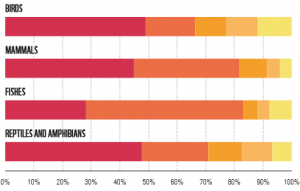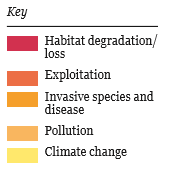Annina Napierala
Climate Change – a word with many faces. For some it’s the end of a discussion, a taboo word so to speak, the dead end of every relationship. For others, it’s the truth, which needs to be spoken out in its full clearance. And then again, some others do not care much about that thing called climate change, by labeling it as just another quirk of the Western society. And this, during a time where the media is filled with news about burning forests in Australia, and days later another topic replaces this: the corona crisis. Additionally, people in my surroundings still seem to find a way to deny climate change, arguing that species will regenerate as they did in history. I would like to dedicate my blogpost to the ones with no voice. The ones we humans often ignore. Honeybees, algae, fungi, the polar ice bear and plants. The whole range of biodiversity is affected by the anthropogenically caused climate change. Not only humans have to face an unknown future. All species living on planet Earth must adapt to the different conditions caused by climate change.
What we know, is what we need to be aware of
There’s no doubt about it
Climate Change – there’s no doubt about it. Observations show that human greenhouse gas emissions, mostly carbon dioxide, have caused approximately 100% of the total global warming since the mid-20th century. This meaning, that human-induced warming nearly reached 1°C above pre-industrial levels in the year 2017. Unfortunately, there is no way to reverse this 1°C of warming and its consequences in the near and distant future. Past emissions are also the ones that cause worldwide problems connected to climate change such as the sea level rise, droughts or the increasing occurrence of extreme weather events. Even if human emissions were immediately reduced to zero, global warming would still reach an additional 0,5°C in the next two to three decades to the reference value of 1°C above pre-industrial levels. Many hypotheses that observe a 1.5°C warmer world exist. However, the way the global warming will transform our planet and its nature is still very much uncertain. And this, especially in the sight of how sharp changes, and the following consequences will be. But it is known that there are, and will be, even more changes to our environment, and with this direct changes in the present form of the nature we know. [1][2]
The role of Nature
Biodiversity matters! Nature, and this includes its biodiversity, provides its population with food, health, energy, security, medicines and genetic resources, ecosystem services that serve our all existence. The facts remain that more than 75% of global food crop types, for example fruits and vegetables, rely on insects and other animals on pollinating. As a complex system characterized by unique ecological and evolutionary processes, nature is providing us with fresh air, clean water and soil, which form the basis of life on earth. Oceans and terrestrial ecosystems build the main sink for human-made carbon emissions. Apart from that, natures’ impact on human health is crucial, may it be as a way to find new medication or just for observing the cultural aspects nature provides its population with. [3][4]
Nature seems to be a perfectly isolated system, but through human activities, we have taken possession of it. Not only the substantial role of providing us with daily needs of living, nature and its biodiversity enable us as homo sapiens to have a powerful impact on the planet Earth. But if our climate changes, nature will change too, and with it, all its habitants from animals to plants. Changes are happening in every aspect of enlivened and inanimate nature. To survive in changed habitats, organisms will have to adapt. However, not every species is be able to follow this co-evolutive process.
Numbers we are facing
Using fossil records as our source of information, an individual vertebrate species lasts at least 1 million years before it becomes extinct. [5] Even though humans haven’t yet been able to count all the existing species, today the total estimated number of different animal and plant species on Earth amounts to 8 million. This number includes 5.5 million insect species. A fraction of about 1 million species of the total 8 million are threatened by extinction, many within the next decades. To put it bluntly, 1 million species face extinction unless action is taken to reduce the drivers of biodiversity loss. Observing these numbers through the lens of the Living Planet Index, a governmental indicator measuring biodiversity which shows the average rate of change over time across a set of species populations, threats of possible species extinction can be brought to light. [3]
Number one on the list: habitat loss and degradation. This refers to the modification of the environment where a species lives and includes terrestrial and freshwater ecosystems which are either completely removed or reduced in their quality of a key habitat. Reason for habitat loss is for the most part agricultural expansion, which takes over one third of the terrestrial land surface. Exploitation is the second biggest driver for species extinction, in particular overexploitation mainly by harvesting, logging and fishing. Invasive species and diseases have gained relevance with an increase in trade and globalization, driving off native species by taking over their habitat. Marine plastic pollution, greenhouse gas emissions, rural waste, industrial pollutants as well as mining and agricultural activities result in negative effects on soil, freshwater and marine water quality. These affect humans through their food chain and also end up affecting nature in its biodiversity. [3][4]

Figure 1: Relative frequency of major threats by taxonomic group [4]

While facing all these factors which lead to biodiversity loss, it must be pointed out that these factors are all created by human activities, the same human activities to which climate change is connected to. Namely – an unsustainable use of our environment. The rising sea levels, increases in extreme weather events, changes in precipitation and a decrease in the ocean’s pH are consequences of climate change and therefore direct drivers for biodiversity loss. Regarding the rapid pace of climate change, species are facing different fates within a short time. Changes in temperature lead to an overlap in seasonal events such as migration and reproduction, causing behavior changes in species. Due to smaller habitats, populations will be smaller too, leading to less genetic diversity and as a consequence less evolutionary potential. This evolutionary potential would be necessary to adapt to different environmental conditions caused by climate change, one example being temperature. Another fact we have to consider, is that a species habitat is more fragmented than in the past. Shifts in species distribution in response to climate-related impacts are therefore a lot more complex. Changes in phenology, altered population dynamics and shifts in species distribution, leads to the assumption that species will either adapt to their new environmental conditions or migrate to different habitats. These are the two different “options” species have rather than going extinct. Considering all the factors which lead to biodiversity loss, the magnitude of change is enormous. Therefore, none of those two possible fates will be sufficient enough to allow many species to deal with current rates of climate change and unstainable livelihoods. [3][4][5]
We must do better
SDGs in context
The maintenance of biodiversity plays an essential role for achieving the Sustainable Development Goals, the SDGs. Not only the SDG 14 “Life below water” and the SDG 15 “Life on Land”, which are directly affected by biodiversity loss, also the Goals related to poverty, food security, energy and education are linked to nature and its biodiversity. Also for the SDG 13 “Climate Action”, sustainability of human activities is required. For reaching future policy targets and creating awareness, the value of biodiversity to human well-being has to be highlighted, as well as biodiversity as a unique good in itself. [3]
Sustainability is the key
Regarding human activities as the cause for climate change and biodiversity loss is a fundamental insight. Therefore, changes in human activities and behavior are required. Unfortunately for us, we are not on the right track. To reach the goal of limiting global warming to 1.5°C above pre-industrial levels, immediate reduction of carbon dioxide emissions until 2030 and net-zero carbon dioxide emissions should be reached at the latest until the decade 2040-2050. This is possible, if no more net emissions of carbon dioxide were created and no more fossil fuels such as coal, oil and gas were being used. Switching to renewable energy in fuel-related industry and creating taxes for carbon dioxide emissions are the fundamental concepts with which global warming can at least be limited. [2] Therefore, rapid and improved deployment of existing policy instruments and new initiatives, which create awareness and at least action towards sustainable use of our environment, need to be enacted. Limitation of land-use, especially the change of conventional agriculture, will stop one of the biggest drivers for biodiversity loss. [3]
To conclude: human actions are needed. In our everyday life, changes seem small but can make a big difference in the overall picture. Starting with the question by which vehicle we go to work with and what we can change in our consumption behavior-, sometimes changes do not have to expand to unrealistic dimensions to make a difference. The most important is that those changes have to happen: now.
References
[1] IPCC Special Report (2015). Allen, M.R., O.P. Dube, W. Solecki, F. Aragón-Durand, W. Cramer, S. Humphreys, M. Kainuma, J. Kala, N. Mahowald, Y. Mulugetta, R. Perez, M. Wairiu, and K. Zickfeld, 2018: Framing and Context. In: Global Warming of 1.5°C. An IPCC Special Report on the impacts of global warming of 1.5°C above pre-industrial levels and related global greenhouse gas emission pathways, in the context of strengthening the global response to the threat of climate change, sustainable development, and efforts to eradicate poverty [Masson-Delmotte, V., P. Zhai, H.-O. Pörtner, D. Roberts, J. Skea, P.R. Shukla, A. Pirani, W. Moufouma-Okia, C. Péan, R. Pidcock, S. Connors, J.B.R. Matthews, Y. Chen, X. Zhou, M.I. Gomis, E. Lonnoy, T. Maycock, M. Tignor, and T. Waterfield (eds.)]. In Press.
[2] Prof. Seneviratne, S. I. (2010, März 25). Climate change, decarbonization and sustainable industry [Vorlesungsunterlagen]. Abgerufen von http://iacweb.ethz.ch/staff/sonia/download/etc/ETH_SDG_032020/Seneviratne_ETH_SDG_March25_2020_new.pdf
[3] IPBES (2019): Summary for policymakers of the global assessment report on biodiversity and ecosystem services of the Intergovernmental Science-Policy Platform on Biodiversity and Ecosystem Services. S. Díaz, J. Settele, E. S. Brondízio E.S., H. T. Ngo, M. Guèze, J. Agard, A. Arneth, P. Balvanera, K. A. Brauman, S. H. M. Butchart, K. M. A. Chan, L. A. Garibaldi, K. Ichii, J. Liu, S. M. Subramanian, G. F. Midgley, P. Miloslavich, Z. Molnár, D. Obura, A. Pfaff, S. Polasky, A. Purvis, J. Razzaque, B. Reyers, R. Roy Chowdhury, Y. J. Shin, I. J. Visseren-Hamakers, K. J. Willis, and C. N. Zayas (eds.). IPBES secretariat, Bonn, Germany. 56 pages.
[4] WWF. 2018. Living Planet Report – 2018: Aiming Higher. Grooten, M. and Almond, R.E.A.(Eds). WWF, Gland, Switzerland.
[5] Reed D.H. (2012) Impact of Climate Change on Biodiversity. In: Chen WY., Seiner J., Suzuki T., Lackner M. (eds) Handbook of Climate Change Mitigation. Springer, New York, NY
Media Attributions
- Grafik1
- Grafik2